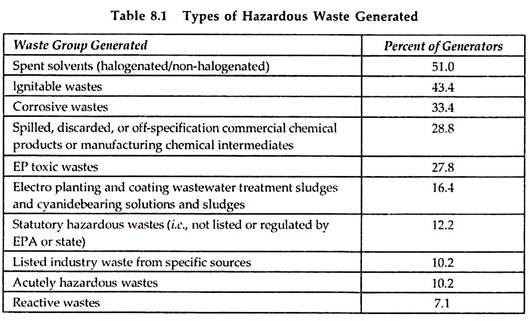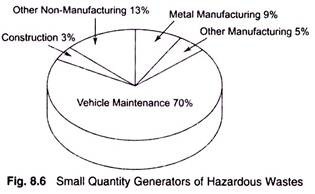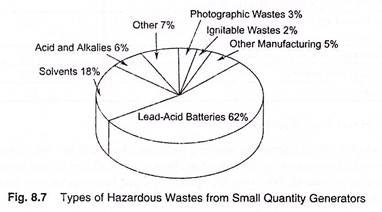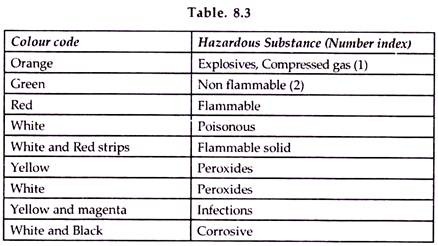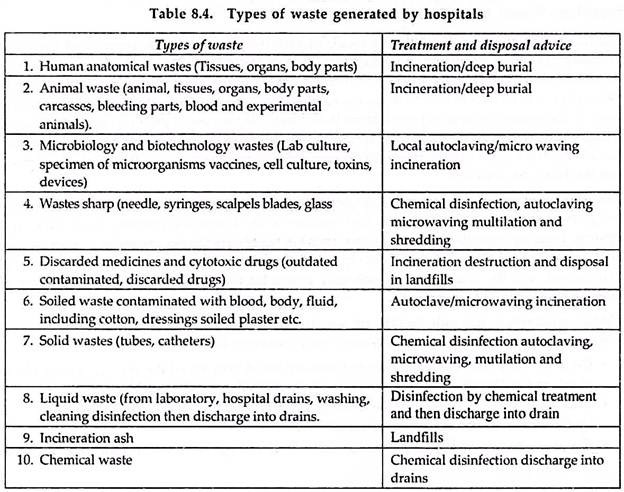Here is an essay on ‘Hazardous Wastes and Its Management’ for class 9, 10, 11 and 12. Find paragraphs, long and short essays on ‘Hazardous Wastes and Its Management’ especially written for school and college students.
Essay Contents:
- Essay on the Meaning of Hazardous Wastes
- Essay on the Large Quantity Generators of Hazardous Wastes
- Essay on the Small Quantity Generators (SQGs) of Hazardous Wastes
- Essay on the Risks of Hazardous Wastes
- Essay on the Objectives for Prevention of Hazardous Wastes
- Essay on the Prevention and Minimization of Hazardous Wastes
Essay # 1. Meaning of Hazardous Wastes:
Hazardous wastes are also around us. Some hazardous wastes are the inevitable by-products of an industrialized society. The staggering variety and amounts of chemicals in production is a key of the types and amounts of hazardous wastes generated by our society. Automobiles, televisions, office chairs, and ball point pens all get their shine from manufacturing processes that produce hazardous wastes. These wastes have been called our Gross National By-products.
Hazardous wastes are legally defined the Resource Conservation and Recovery Act (RCRA) as a solid, or combination of solid wastes, which because of its quantity or concentration; or physical, chemical or infectious characteristics may cause, or significantly contribute to an increase in mortality or an increase in serious irreversible or incapacitating reversible illness; or pose a substantial present or potential hazard to human health or the environment when improperly treated, stored, transported, or disposed of, or otherwise managed.
For a material to be defined by RCRA as a hazardous waste, it must be a solid waste. The RCRA definition of solid waste distinguishes between waste and all other materials. For example, a hazardous material used in a manufacturing process is not covered under RCRA because it is not a waste.
A solid waste has been defined by the RCRA:
1. A solid, liquid, semi-solid, or contained gas
2. Any garbage, refuse, sludge, or other waste material not specifically excluded under 40 CFR.
3. Any other waste material resulting from industrial, commercial, mining, or agricultural operations or community activities, which:
(a) Is discarded or accumulated, stored, or physically, chemically, or biologically treated prior to being discarded; or
(b) Has served its originally intended use and sometimes is discarded; or
(c) Is a manufacturing or mining by-product and sometimes is discarded.
Specifically, a solid waste is determined to be a hazardous waste if; it is not exempted from the regulation; it has certain specific characteristics; it is listed in the regulations as hazardous; or it is broadly classified as a statutory waste because it can cause harm to humans or the environment, regardless of whether it is presently regulated.
The term hazardous waste has a specific legal definition, which is defined in the RCRA law. When hazardous waste is used in a regulatory sense (as is used here) it refers to a specific waste that is regulated by RCRA. Thus, the regulatory term hazardous waste is not interchangeable with any other phrase. For example, the phrases chemical waste and wastes that have chemical hazards carry no regulatory meaning.
Exempted waste:
Certain categories or wastes are not subject to RCRA hazardous waste controls.
The following examples are wastes that are excluded:
1. Waste discharge regulated under the Clean Water Act, e.g., industrial effluents.
Note:
This exclusion applies only to the actual point source discharge. It does not exclude industrial wastewaters while they are being collected, stored or treated before discharge, not does it exclude sludges that are generated by industrial wastewater treatment.
2. Nuclear wastes regulated under the Atomic Energy Act.
3. Household wastes (only if they do not contain hazardous waste)
4. Coal combustion wastes
5. Soil fertilizers used in agriculture
6. Drilling muds and brines used in oil, gas and geothermal explorations
7. Mining wastes, as from extraction, treatment, and processing of ores and minerals
8. Cement kiln dust
9. Wastes produced by very small quantity generators.
Characteristic waste:
A waste is classified as hazardous, and is subject to federal regulations, if it exhibits one or more of the following characteristics:
Ignitability, Corrosivity, Reactivity, or Extraction Potential (EP) toxicity.
(a) Ignitable:
A solid waste is ignitable if it has a flashpoint of less than 140 °F. (A flashpoint is the lowest temperature to which a material can be heated to give off sufficient vapour to form an ignitable mixture with the air near the surface of the material).
(b) Corrosive:
A solid waste is corrosive if it has a pH of less than or equal to 2.0 (acidic), or equal to or greater than 12.5 (basic); or it corrodes standard steel containers at a rate greater than 6.35 mm (0.250 inch) per year.
(c) Reactive:
A solid waste is reactive if it is normally unstable and readily undergoes violent with water, forms potentially explosive mixture with water; or forms fumes, toxic gases or vapors in sufficient concentrations to endanger human health or the environment.
Extraction Procedure (EP) Toxic Wastes:
EP toxic wastes contain certain materials (toxic metals and/or certain organic compounds) that can be released when mixed with slightly acidic water. The presence of toxic materials is determined by using an Extraction Procedure (EP) specified by the EPA, which is designed to simulate the leaching action that occur in landfills.
The EPA proposed to amend its hazardous waste identification regulations by modifying the exiting Extraction Procedure Toxicity Characteristics (EPTC) an introducing a new leach procedure, the Toxicity Characteristic Leaching Procedure (TCLP).
Listed Wastes:
A waste is subject to the RCRA regulations if it is included on lists of wastes considered hazardous by the EPA.
There are three following lists:
1. The F lists of hazardous wastes from nonspecific sources (e.g., wastewater treatment sludges from electroplating operations).
2. The K list of hazardous waste from specific sources (e.g., bottom sediment sludge from treatment of wastewaters from wood preserving).
3. Discarded commercial chemical products (the U and P lists) containers, and spill residues. The products on the U list are called toxic wastes (e.g., vinyl chloride). Those on the P list are called acute hazardous wastes (e.g., cyanides), and are subject to more rigorous controls that the other listed hazardous wastes.
Statutory Waste:
A statutory waste may be legally hazardous as defined by Congress; however, since the EPA has not yet formulated all the specific rules to control hazardous waste, a statutory waste may not yet be regulated.
The statutory definition of a hazardous waste is particularly important because the legal liability of the generator is long-term, extending through the life of the waste. Some hazardous wastes are persistent, slow to decompose chemically and/or biochemically.
As a consequence, for its own protection, an institution may classify and manage a waste as hazardous characteristics specified in the federal regulations and is not a listed waste. The ration able is that, if the institution did not declare the waste as hazardous, the institution may run the risk of future liability if this originally non-hazardous material were found to cause harm.
Essay # 2. Large Quantity Generators of Hazardous Wastes:
Manufacturing industries, small businesses, households, hospitals, research and testing laboratories and the agriculture industry are among the generators of hazardous wastes. A survey was conducted in 1981; the data are from larger quantity generators sources generating more than 1000 kilogram per month of hazardous waste.
Essay # 3. Small Quantity Generators (SQGs) of Hazardous Wastes:
An office of solid waste survey estimated that there were more than 650,000 businesses that generate hazardous waste in the U.S. Of this number, more than 100,000 produce over 2.20 lacs lbs., of hazardous waste per month.
Another report, the EPA estimates that the new RCRA will increase the number of federally regulated waste generators from about 15,000 to about 175,000. An EPA survey in March, 1985 suggested that 85% of the SQGs are in the vehicle maintenance, equipment repair, construction, printing, photography, laboratories, schools, laundries, dry cleaning, and pesticides application industries, Most of the remainders are in manufacturing of finishing of metals.
What Types of Hazardous Wastes do SOGs Generate?
Small quantity generators are responsible for less than 0.5% of all domestic hazardous wastes, according to John Skinner, Director, U.S. EPA office of solid waste. They produce only 800,000 metric tons per year of hazardous waste compared to 250 million metric tons from large companies. The types of hazardous waste generated by SQGs are essentially similar to those generated by larger quantity generators.
To the extent that this is true, the move to regulate small quantity generators is appropriate. More than 10 million tons per year of hazardous wastes. Most of this waste is disposed of in municipal landfills not licensed to accept hazardous waste, or are burned in mass burn and energy recovery incinerators, which may not be licensed to burn hazardous wastes.
Household solid waste is not legally classified as hazardous. Present federal low exempts house hold solid wastes from RCRA regulations. However, Congress was apparently ambivalent when it incorporated the household waste exclusion into the law.
For example, it provided that a resource recovery facility recovering energy from burning municipal waste if the facility receives and burns only household waste and non-hazardous waste from other sources, and does not accept hazardous wastes.
There appears to be a trend mass burn solid waste incineration and energy recovery. This trend is spurred by the increasing costs of land filling and by the difficulty of sitting new landfills. However, the concerns over household hazardous wastes and the increasing use of plastics in products and packaging have led to a lively debate over the human health and environmental impacts of household waste incineration, especially in non-RCRA, permitted mass-bum and energy- recovery facilities. Many areas have already taken measures to properly manage household hazardous wastes. Table 8.2 shows examples of household and small business hazardous waste disposal programs in many areas.
Essay # 4. Risks of Hazardous Wastes:
Many ecologic incidents that called attention to environmental concerns more than 30 years ago are behind the hazardous waste concerns in Agenda 21. These events played fundamental roles in the enactment of legislation to control hazardous waste, because of evidence of both negative health impacts and elevated costs associated with their inadequate disposal.
Such is the case of the first-reported major incident of mercury poisoning, which arose from discharge of industrial wastes into Minamata Bay in Japan. The resulting effects on individuals disease of the central nervous system were described as early as 1956. Other well-publicized releases of toxic chemical from chemical waste disposal sites include Love Canal, New York, and Lekkekerk in the Netherlands. In both incidents, evacuation of residents from the affected communities and clean-up of the sites occasioned great social and financial expenses.
Essay # 5. Objectives for Prevention of Hazardous Wastes:
Four program areas are proposed in Agenda 21 to attain the overall objective. Within the framework of integrated life cycle management, to prevent to the extent possible, and minimize, the generation of hazardous wastes, as well as to manage those wastes in such a way that they do not cause harm to health and the environment.
These program areas include:
1. Avoid or reduce generation of hazardous wastes.
2. Dispose of wastes as close as possible to the place where they are generated.
3. Manage wastes in an environmentally sound and efficient way.
4. Optimize environmentally sound recovery of wastes.
5. Preventing illegal international traffic in hazardous wastes.
6. Promoting and strengthening institutional capacities in hazardous waste management.
7. Promoting and strengthening international cooperation in the management of transboundary movements of hazardous wastes.
8. Promoting the prevention and minimization of hazardous wastes.
9. Reduce to a minimum or eliminate transboundary movements of hazardous wastes.
Essay # 6. Prevention and Minimization of Hazardous Wastes:
The specific economic and environmental benefits of industrial source reduction preventing the generation of wastes in the first place rather than cleaning them up after they have been created. Source reduction activities conducted by this group of chemical plants resulted in a significant decreases in releases of toxic and hazardous wastes, saved money and were associated with increases in product yields; and the capital cost of implementing them was nonexistent, reduced, or was paid back in less than 2.5 years.
Transportation:
Transportation of hazardous substances are regulated by law. EPA has given instructions regarding packaging, marking and labelling. The material container should be inert to hazardous waste. Colour labels are being used to indicate hazardous substances while transporting.
Hazardous Wastes from Hospitals:
Healthcare wastes are generated as a result of activities related to the practice of medicine (including veterinary medicine and dentistry). Often this term is used to refer only to solid wastes (i.e., not to wastewater). Some of the healthcare wastes coming from any particular hospital or institution are similar in nature to domestic solid wastes, and may be called “general healthcare wastes”.
The remaining wastes pose serious health hazards because of their physical, chemical or biological nature, and so are known as “hazardous healthcare wastes” or “healthcare risk wastes”. Wastes which are particularly offensive because of their appearance or smell may also be classed with the hazardous wastes.
Healthcare wastes have attracted considerable attention because of the emotional impact of seeing body parts amidst solid waste, and because of the increasing concern about AIDS and hepatitis. In many cases the most dangerous items in healthcare wastes are needles from syringes and drips, because the needles shield the viruses from chemical disinfectants and a harsh external environment, and the sharp point allows easy access for the viruses into the blood stream of anyone who is pricked by the needle.
Many attempts to upgrade healthcare waste management rely solely of the provision of incinerators or other treatment technologies.
Such a strategy has several weaknesses in that:
(i) Often the hospitals and healthcare facilities are not able to afford the operating costs of the plant, and so the plants are left unused or not repaired when they break down.
(ii) Many of the risks occur before the waste gets to this final stage, and so they are not reduced by the provision of treatment equipment.
(iii) The real need is often provide better methods of storage to train the staff to adopt safer working practices.
Hazards Associated with Biomedical Wastes:
Proper disposal of bio medical wastes is necessary as these are infectious and hazardous.
Improper disposal can lead to the following dangerous situations:
1. Organic portion ferments and attracts fly breeding.
2. Injuries from sharp broken instrument, syringe etc., to the healthcare and waste handling persons.
3. Increased risk of infections to medical nursing and other staff.
4. Poor infection control may lead to infections of patients with HIV, hepatitis B and C.
5. Increases risk of drugs being handled by persons handling wastes.
6. Poor waste management encourages unscruprous persons to recycle the materials from waste.
7. Development of resistant strains by microorganisms.
Mainly the medical persons, nurses, patients, health workers, laboratory personnel are at risk of infections. If the waste is not disposed properly, pathogens can pollute, soil, water and air and cause health hazard for general public.
Other Hazardous and Special Wastes:
Some waste materials need special care because their properties make them more hazardous or problematic than general wastes. Used oil can be refined for reuse of burned in properly equipped furnaces. Slaughterhouse wastes should be buried in special trenches as suitable sites. Car tyres should be reused as much as possible, and carefully protected from open burning.
Chemical wastes from some industries (including tanning, dry cleaning, photographic processing and many chemical production industries) and unwanted pesticides and other agricultural chemicals, should be collected under close supervision and treated in appropriate ways.
The management of hazardous chemicals is not only a matter of technology and legislation, but also of enforcement, funding and financial instruments. Some wastes are so hazardous and expensive to treat that priority attention should be focussed on changing to processes that use substitutes that are less hazardous; and to minimising the quantities that are discarded. Indeed, minimisation and substitution should be seen as the preferred options in dealing with any difficult waste.
The Basel Convention seeks to control the movement of hazardous wastes across international boundaries. This instrument is necessary because the high cost of treating hazardous wastes in industrialized countries makes it financially attractive to ship the wastes to another country where no special requirements for their disposal will be applied.
